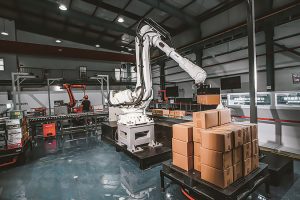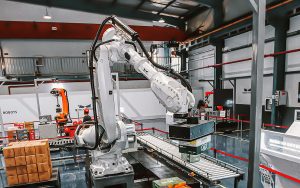While much of business has seemingly returned to “normal” in some capacity since the beginning days of the pandemic, there are still many hurdles that are facing nearly every industry, primarily that of labor shortages and keeping up with high demand. For many manufacturers, embracing new technologies in industrial automation has helped them pivot and fill in crucial gaps. From cobots (collaborative robots) to customized picking and placing solutions and more, discover how your business can increase productivity and meet its unique needs with industrial automation solutions.
Leverage New Technologies to Combat the Labor Shortage
Over the last couple of years, the labor shortage was initially brought on by COVID-19, but was then perpetuated by “the Great Resignation”. This shift in today’s job market has several contributing factors, including those looking to move to higher paying jobs, start a new career path, or retire altogether. With this in mind, many companies turned to industrial automation to help address the gaps their companies are experiencing.
In fact, according to a survey conducted by UiPath, 63% of U.S. executives say their companies are struggling with the current labor shortage and 78% of them claim that they will invest in automation to help close productivity gaps.
That’s why it’s now more important than ever for your company to consider the ways in which robotics and automation services can help increase your production efforts. While the labor shortage has increased the interest in adopting automation in the industrial industry, it’s certainly not a short-lived fad. According to McKinsey Global Institute, 60% of production potential will likely come from automation and digitization. By joining the increasingly growing list of companies investing in these new technologies, your business can stay ahead of the competition and be better prepared to face the ever-changing labor landscape with confidence.
Lighten Your Workforces’ Load & Increase Worker Productivity
 Not only can automation technologies aid in filling gaps due to labor shortages, they can also help you retain existing employees by decreasing manually intensive activities and increasing worker productivity. In manufacturing, there are a multitude of repetitive tasks that could be relegated to robotics and automation services to alleviate stress injuries for your workers. Through assigning some of the more manually intensive activities to automation technologies, workers can avoid poor posture, repeated motions, and heavy lifting.
Not only can automation technologies aid in filling gaps due to labor shortages, they can also help you retain existing employees by decreasing manually intensive activities and increasing worker productivity. In manufacturing, there are a multitude of repetitive tasks that could be relegated to robotics and automation services to alleviate stress injuries for your workers. Through assigning some of the more manually intensive activities to automation technologies, workers can avoid poor posture, repeated motions, and heavy lifting.
Automation can also create a safer workplace culture by limiting the need for your people to be exposed to hazardous elements in production. This can help keep your team safe and allow them to distance themselves from the action by working with cobots (collaborative robots). A great example of how skilled positions can avoid dangerous situations in their work through automation would be in low-oxygen environments.
Additionally, this relegation can allow your workers to focus on some of the more complex tasks, as well as create new career opportunities. As seen from “the Great Resignation”, one of the key desires from today’s workforce is to expand their skillset and continue to grow within their career. New technologies will allow employees to adapt and hone new skills through training and working with robotics and automation.
Discover the Possibilities with Industrial Automation

If you’re looking to increase production and quality of performance for your company, automation partners, like our engineering services team at IBT Industrial Solutions, can help you integrate computer control and multi-axis motion capabilities within your system. Robotics and industrial automation services can apply to several applications, including material handling, palletizing/depalletizing, machine tending, food and pharmaceutical packaging, and more. To understand your options, we’ve broken down some of the most common industrial automation solutions for manufacturing:
Robotics
Most robots are considered a flexible automation solution as, typically, they can be reprogrammed and retooled for many different applications and are highly customizable. Robots are an excellent investment, as they do not become functionally obsolete and can be integrated into a unified production process.
Pick and Place
Pick and place robots are an example of a fixed solution, as they are most often designed for a specific purpose. Pick and place robots are the perfect solution for speeding up production and keeping performance consistent, and are most commonly used in assembly, packaging, bin picking, and inspection.
Automation Controls
Automation controls can assist in retrofits and drive efficiencies to help modernize plant operations. These controls typically span across PLC, motion, and CNC. Upgrading controls is a great way to give your machinery a new lease on life.
Partner with IBT for Your Industrial Automation Solutions
Interested in optimizing your system to move faster and more smoothly? Contact us today to learn how our experienced engineering services team can develop, design, and install an automated solution that will help you pivot in today’s ever-changing market and stay ahead of the curve.
To learn more about our robotics and automation services at IBT, visit our engineering services page.





